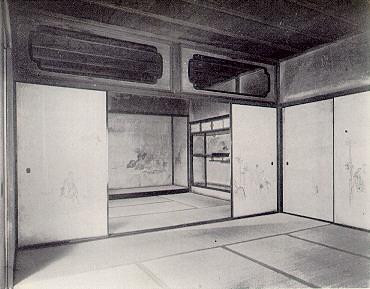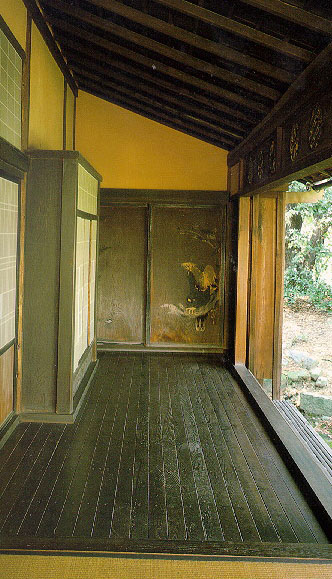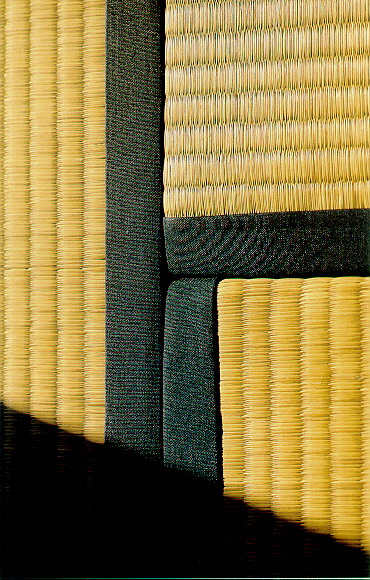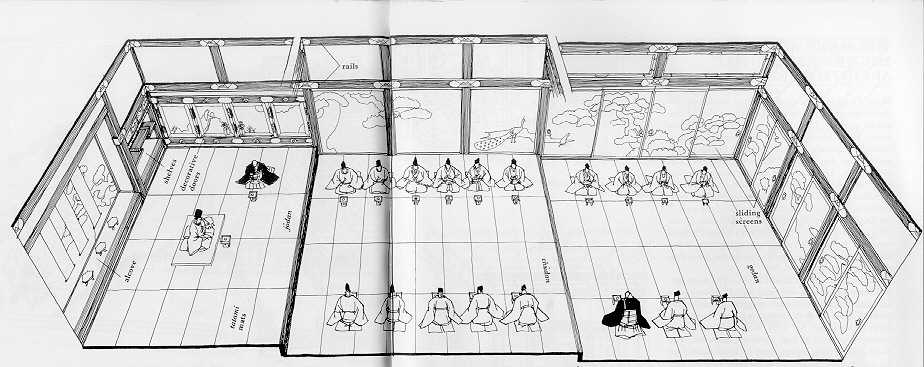 The
Fusuma were large interior sliding screens. They were cover with heavy
paper and either painted or left plain. The function of these screens were
to partition the space within a room, as well as to partition to room itself.
The
Fusuma were large interior sliding screens. They were cover with heavy
paper and either painted or left plain. The function of these screens were
to partition the space within a room, as well as to partition to room itself.
Not all of the elements of shoin architecture function
as an element for display. Some were used as a direct result of concious
architectural implementation.
 The
Fusuma were large interior sliding screens. They were cover with heavy
paper and either painted or left plain. The function of these screens were
to partition the space within a room, as well as to partition to room itself.
The
Fusuma were large interior sliding screens. They were cover with heavy
paper and either painted or left plain. The function of these screens were
to partition the space within a room, as well as to partition to room itself.

Shoji Screens are the exterior sliding screens that usually
lead to a veranda area. These screens consist of white opaque paper, fixed
to an wooden lattice frame.

 Tatami
mats replaced the plain wood floors of the palace style architecture. The
tatami are considered the most influential element that flourished through
the use of shoin architecture. Forms of tatami mats existed since the Heian
period (782-1184). Then they were used as a status symbol with ornate embroderies
illustrating the class. It is recorded that during the middle ages mats
were woven and permanently installed in rooms. Since the mats were permanent
and the type of mat was consitent throughout, the class division was made
by whether or not someone was seated on a mat. The difference in height
of the mat-user and the non-mat-user was approximately 5 centimeters. Finally,
when this form entered the Muromachi period, the tatami developed into
fully cover tatami floors, a solely shoin invention. As a result of this
invention there was a need to shifted levels in order to separate the classes
once again.
Tatami
mats replaced the plain wood floors of the palace style architecture. The
tatami are considered the most influential element that flourished through
the use of shoin architecture. Forms of tatami mats existed since the Heian
period (782-1184). Then they were used as a status symbol with ornate embroderies
illustrating the class. It is recorded that during the middle ages mats
were woven and permanently installed in rooms. Since the mats were permanent
and the type of mat was consitent throughout, the class division was made
by whether or not someone was seated on a mat. The difference in height
of the mat-user and the non-mat-user was approximately 5 centimeters. Finally,
when this form entered the Muromachi period, the tatami developed into
fully cover tatami floors, a solely shoin invention. As a result of this
invention there was a need to shifted levels in order to separate the classes
once again.
